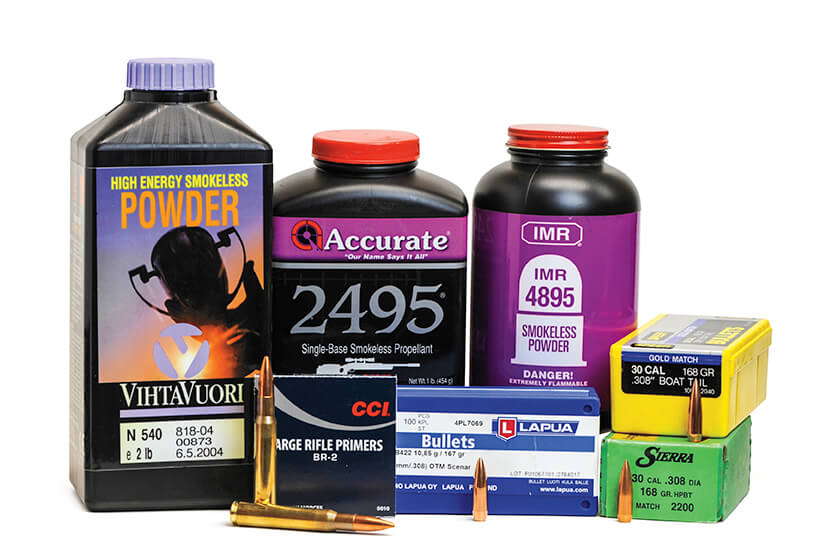
Safe .30-06 handloads for the M1 Garand require a recommended charge of between 44 and 50 grains of a medium burn rate propellant.
The M1 Garand was described by Gen. George S. Patton as “the greatest battle implement ever devised!” That might be true, but while it is rugged and reliable, the gas-operated semiautomatic rifle is peculiar when it comes to the ammunition it likes. Before you start to handload for it, let me share a few pointers you’ll do well to follow to avoid excess wear and tear and potential damage to your M1 Garand.
Although it’s chambered for the .30-06 cartridge, the rifle was designed to fire a specific concoction of propellant and bullet type/weight. Most .30-06 commercial hunting ammunition uses propellants that cause excessive port pressures and generate too much gas, and it can damage the rifle’s operating rod, bolt, and receiver. There is some factory-loaded ammo made specifically for the M1 Garand, and you’d be well-advised to stick with it.
The same caution applies to reloading for the M1 Garand. Western Powder’s load manual says to use 44 to 50 grains of a propellant with a medium burn rate topped with a 150- to 173-grain bullet. IMR 4895 was the propellant used in the original military ball ammo, and the M2 round launches a 147- to 152-grain FMJ flatbase Spitzer bullet at around 2,800 fps. The M72 match ammo fires a 172- to 174-grain FMJ boattail Spitzer bullet at a muzzle velocity of about 2,640 fps. Both loads are “tuned” to properly power the M1’s operating rod system and reliably cycle the M1’s rather intricate action.
I chose to load 167-grain and 168-grain HPBT match bullets, and Creedmoor ammunition topped with 167-grain Lapua Scenar match bullets and Hornady 150-grain FMJ ammo were the only two factory loads available to shoot for comparison. I had Federal 210M and CCI BR-2 match primers and Speer and Sierra bullets and on hand, and Capstone Precision provided 167-grain Scenar component bullets. I used Federal cases for all handloads.
Obviously, a self-loading rifle does not have the bolt action’s shooter-assisted torque to reliably chamber a round. If the reloaded round is a bit too large or misshapen at all, there’s a good chance it will jam the action. No problem—just full-length resize the brass.
You must also check case length and trim if needed to avoid two potential problems. First, if the neck length is really excessive, the round likely won’t chamber. However, if it’s only a bit too long, the round may chamber, crimping the case mouth onto the bullet. That condition impedes releasing the bullet when the round is fired, causing increased pressure.
Once the mandatory case prep (including inspecting for cracks or other visual damage after cleaning) is done, clean and uniform the primer pockets. It only takes a few extra minutes to do and ensures the primers can be seated to the proper depth. You definitely do not want to chamber a round with a high primer and suffer a slam-fire!
The medium burn rate propellants I used included Hodgdon Varget, IMR 4895, Accurate 2495 and 2520, Ramshot TAC, Alliant AR-Comp, and VihtaVuori N540. While charging the first batch of test loads, I noticed the propellant load density was less than 75/80 percent. I checked the charge weight again just to be sure I’d adjusted the measure correctly.
Maximum overall length for the .30-06 is 3.340 inches; however, you don’t want to load your bullets out so far that they engage the leade in the chamber. This will surely cause increased pressures when the round is fired. The load manuals recommend backing off at least 0.040 inch to make sure you avoid that condition.

The M1 is not readily adaptable to mounting a scope, but my 1957-vintage Springfield Armory rifle’s iron sights are easy to adjust and were reasonably compatible to my aging eyesight. I fired a couple of 25-yard groups with each test load to gather velocity data and gauge accuracy potential. Later, I set up large, brightly colored targets at 50 yards to see just how good I could shoot it.
As you can see from the chart, I was able to closely duplicate the Creedmoor factory load’s velocity with my 167-grain Scenar handloads. Since the rifle weighs about 10 pounds, I fired up to 40 rounds during each range session without the cumulative recoil bothering me at all. I pulled a Bore Snake through the barrel a couple of times after firing each 10- or 15-round string and thoroughly cleaned the rifle after returning from the range.
One thing I noticed right away about the velocity data recorded by the chronograph was that if I lifted the muzzle up between shots, average velocity ran from 40 to 50 fps faster and the shot string exhibited noticeably less extreme spread and standard deviation. I promptly incorporated the “powder positioning” step into my bench shooting routine and followed it most of the time.
Later, while firing another 10-shot string, I forgot to lift the muzzle skyward before the eighth round. I immediately realized my mistake and mentally noted to check the chronograph. Sure enough! The seventh and ninth shots were 100+ fps faster. The fourth reading was also about 75 fps less than the rest, so I had likely forgotten the proper routine for that one, also.
All things considered, I really enjoyed working up handloads for my M1 rifle. If you have the opportunity to acquire an M1 and plan to handload for it, treat it gently and you’ll likely have a good experience, too.
M1 Garand Accuracy & Velocity Chart












































